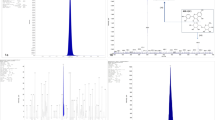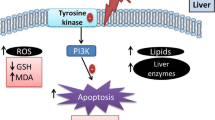Abstract
Fructose consumption is responsible for the onset of insulin resistance (IR), and metabolic syndrome. It possesses no functional utility in body and its detrimental effects on hepatic metabolic milieu are beyond those produced by glucose. The need of the hour is to identify fructose-induced IR as an unique pathological state to be managed differentially. The effect of aqueous leaf extract of Aegle marmelos (AM) on hepatic markers of insulin resistance using HepG2 cells cultured in either fructose or glucose-rich environment is investigated. Human hepatocellular carcinoma cells (HepG2) were grown under standard conditions in either—DMEM without glucose (NC), DMEM with high glucose 25 mM (Glu), DMEM-glucose+0.55 mM fructose (FC1), DMEM-glucose+1 mM fructose (FC2) or DMEM-glucose+1 mM fructose+0.1 µM insulin (FC3). The cells were treated with either AM, rutin, quercetin, metformin or pioglitazone and assessed for levels of hexokinase, phosphofructokinase (PFK), aldehyde dehydrogenase, phosphatidylinositol kinase (PI3K), signal transducer and activator of transcription-3 (STAT-3), mitochondrial target of rapamycin (mTOR), hypoxia-induced factor (HIF-1α), vascular endothelial growth factor (VEGF) and tumour necrosis factor (TNF-α). Summarily, when results from fructose- and glucose-rich environment were compared, then (1) IR was more pronounced in former; (2) AM performed better in former; (3) metformin and pioglitazone were equivocal in either; (4) rutin and quercetin showed deviant effects from AM; and lastly (5) effects of rutin were closer to AM than quercetin. We hypothesize that AM ameliorates fructose-induced IR through a mechanism which is distinct from standard drugs and not shared by individual phytoconstituents in toto.










Similar content being viewed by others
References
Kahn BB, Flier JS (2000) Obesity and insulin resistance. J Clin Invest 106:473–481
Meigs JB (2003) Epidemiology of the insulin resistance syndrome. Curr Diab Rep 3:73–79
Goran MI, Dumke K, Bouret SG, Kayser B, Walker RW, Blumberg B (2013) The obesogenic effect of high fructose exposure during early development. Nat Rev Endocrinol 9:494–500
Lustig RH (2010) Fructose: metabolic, hedonic, and societal parallels with ethanol. J Am Diet Assoc 110(9):1307–1321. doi:10.1016/j.jada.2010.06.008
Basciano H, Federico L, Adeli K (2005) Fructose, insulin resistance, and metabolic dyslipidemia. Nutr Metab (Lond) 2:5
Douard V, Ferraris RP (2013) The role of fructose transporters in diseases linked to excessive fructose intake. J Physiol 591:401–414
Miller A, Adeli K (2008) Dietary fructose and the metabolic syndrome. Curr Opin Gastroenterol. 2:204–209. doi:10.1097/MOG.0b013e3282f3f4c4
Zavaroni I, Sander S, Scott S, Reaven GM (1980) Effect of fructose feeding on insulin secretion and insulin action in the rat. Metabolism 29:970–973
Rebollo A, Roglans N, Alegret M, Laguna JC (2012) Way back for fructose and liver metabolism: bench side to molecular insights. World J Gastroenterol 18(45):6552–6559. doi:10.3748/wjg.v18.i45.6552
de Moura LP, Souza Pauli LS, Cintra DE, de Souza CT, da Silva AS, Marinho R, de Melo MA, Ropelle ER, Pauli JR (2013) Acute exercise decreases PTP-1B protein level and improves insulin signaling in the liver of old rats. Immun Ageing 10(1):8. doi:10.1186/1742-4933-10-8
Zheng X, Ke Y, Feng A, Yuan P, Zhou J, Yu Y, Wang X, Feng W (2016) The mechanism by which amentoflavone improves insulin resistance in HepG2 cells. Molecules 21(5):624. doi:10.3390/molecules21050624
Maity P, Hansda D, Bandyopadhyay U, Mishra DK (2009) Biological activities of crude extracts and chemical constituents of Bael, Aegle marmelos (L.) Corr. Indian J Exp Biol 47(11):849–861
Wolever TM (2000) Dietary carbohydrates and insulin action in humans. Br J Nutr. 83(1):S97–S102
Ueno M, Bezerra RM, Silva MS, Tavares DQ, Carvalho CR, Saad MJ (2000) A high-fructose dietinduces changes in pp185 phosphorylation in muscle and liver of rats. Braz J Med Biol Res 33:1421–1427
Ansari P, Afroz N, Jalil S, Azad SB, Mustakim MG, Anwar S, Haque SM, Hossain SM, Tony RR, Hannan JM (2017) Anti-hyperglycemic activity of Aegle marmelos (L.) corr. is partly mediated by increased insulin secretion, α-amylase inhibition, and retardation of glucose absorption. J Pediatr Endocrinol Metab 30(1):37–47. doi:10.1515/jpem-2016-0160
Handa SS, Kapoor VK, Goel AK, Tandon N (eds) (2010) Phytochemical reference standards of selected Indian medicinal plants, vol 1. Medicinal PlantsUnit, Indian Council of Medical Research, New Delhi
Brandstrup N, Kirk JE, Bruni C (1957) The hexokinase and phosphoglucoisomerase activities of aortic and pulmonary artery tissue in individuals of various ages. J Gerontol 12:166–171
Kraemer RJ (1968) Isolation and characterization of human liver aldehyde dehvdrogenase. J Biol Chem 243:6402–6408
Elliott SS, Keim NK, Stern JS, Teff K, Havel PJ (2002) Fructose, weight gain, and the insulin resistance syndrome. Am J Clin Nutr 76:911–922
Mayes PA (1993) Intermediary metabolism of fructose. Am J Clin Nutr 58:754S–765S
Chen Q, Wang T, Li J, Wang S, Qiu F, Yu H, Zhang Y, Wang T (2017) Effects of natural products on fructose-induced nonalcoholic fatty liver disease (NAFLD). Nutrients 9:96
Tiwari AK, Rao JM (2002) Diabetes mellitus and multiple therapeutic approaches of phytochemicals: present status and future prospects. Curr Sci 83(1):30–38
Berg JM, Tymoczko JL, Stryer L (2002) Biochemistry, 5th edn. Freeman WH, New York
Hamer MJ, Dickson AJ (1990) Control of glycolysis in cultured chick embryo hepatocytes. Fructose 2, 6-bisphosphate content and phosphofructokinase-1 activity are stimulated by insulin and epidermal growth factor. Biochem J 269(3):685–690
Hellerstein MK, Schwarz JM, Neese RA (1996) Regulation of hepatic de novo lipogenesis in humans. Annu Rev Nutr 16:523–557
Carroll VA, Ashcroft M (2006) Role of hypoxia-inducible factor (HIF)-1alpha versus HIF-2alpha in the regulation of HIF target genes in response to hypoxia, insulin-like growth factor-I, or loss of von Hippel-Lindau function: implications for targeting the HIF pathway. Cancer Res 66:6264–6270
Hyun B, Shin S, Lee A, Lee S, Song Y, Ha NJ, Cho KH, Kim K (2013) Metformin down-regulates TNF-α secretion via suppression of scavenger receptors in macrophages. Immune Netw 13(4):123–132. doi:10.4110/in.2013.13.4.123
Kim J, Song G, Wu G, Bazer FW (2012) PNAS Plus: functional roles of fructose. Proc Natl Acad Sci 109:E1619–E1628
Author information
Authors and Affiliations
Corresponding author
Rights and permissions
About this article
Cite this article
Aggarwal, H., Nair, J., Sharma, P. et al. Aegle marmelos differentially affects hepatic markers of glycolysis, insulin signalling pathway, hypoxia, and inflammation in HepG2 cells grown in fructose versus glucose-rich environment. Mol Cell Biochem 438, 1–16 (2018). https://doi.org/10.1007/s11010-017-3108-8
Received:
Accepted:
Published:
Issue Date:
DOI: https://doi.org/10.1007/s11010-017-3108-8




